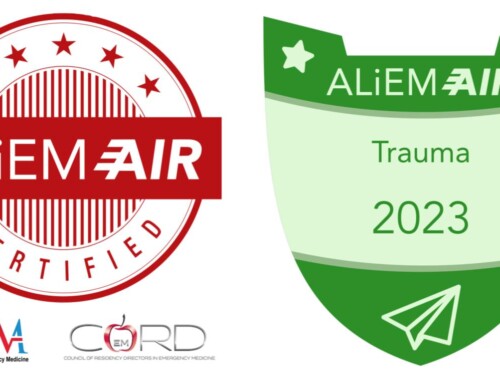 Case: 55-year-old restrained driver is reporting severe shortness of breath and right sided chest pain after a high-speed motor vehicle collision. Her respiratory rate is 26 breaths/min and her oxygen saturation is 96% on a 15-liter non-rebreather. She has decreased breath sounds on the right, epigastric tenderness, and an abdominal seatbelt sign. What is the diagnosis?
Case: 55-year-old restrained driver is reporting severe shortness of breath and right sided chest pain after a high-speed motor vehicle collision. Her respiratory rate is 26 breaths/min and her oxygen saturation is 96% on a 15-liter non-rebreather. She has decreased breath sounds on the right, epigastric tenderness, and an abdominal seatbelt sign. What is the diagnosis?
Poll Results
[plot id=”1″] [su_spoiler title=”Answer” style=”fancy” icon=”caret”]Diaphragmatic Rupture
Explanation
The CXR shows a prominent elevation of the right hemidiaphragm (red arrow) and consolidation in the right upper lobe (yellow arrow) with no visible pneumothorax or fracture. Ruptured diaphragm or significant hemothorax should be at the top of the differential.
The CT scan confirms the diagnosis of right sided diaphragm rupture and shows
- Significant superior extension of the liver with the dome reaching the level of the carina
- Mediastinal shift to the left
- Small right pleural effusion
- Almost complete consolidation of the right lung
- Fractures of the right fourth, seventh, eighth ribs, and a fracture of the left L5 transverse process
Traumatic right-side diaphragmatic ruptures are less common than left sided ones because the liver behaves like a shield absorbing the intra-abdominal force in blunt trauma.1
Diaphram rutpture by the numbers
- 70-80% – cases are left-sided diaphragmatic ruptures
- 15-25% – cases are right-sided ruptures
- 5-8% – cases are bilateral ruptures2
- 10x – increase in intra-abdominal pressure in deceleration injuries, especially if the patient is holding his/her breath and/or contracts abdominal muscles at the time of impact3
This increase in the pressure gradient across the diaphragm causes shearing of the diaphragm from its attachments.4 The significant force required to rupture the diaphragm usually causes other significant injuries, including:5
- Shock
- Respiratory failure
- Visceral injury
- Neurological injury.
Consequently, diaphragmatic injuries are easily missed in the acute presentation due to other organ injuries that may complicate the clinical picture.5
Master Clinician Bedside Pearls
Danielle Campagne, MD FACEP
Assistant Clinical Professor of Emergency Medicine
University of California San Francisco – Fresno







